LENS
Reimagined Education
New campus brings health students under one roof to learn and work together
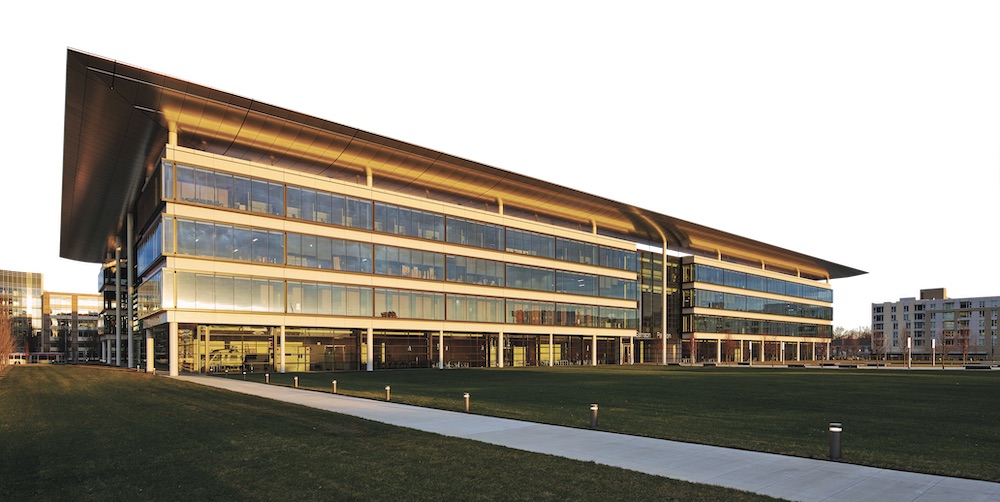 PHOTO: Roger Mastroianni
PHOTO: Roger MastroianniStudents at the new Samson Pavilion will be educated for team-based care in a building offering pioneering technologies and opportunities to learn and collaborate together. The building can take on a golden hue during early morning hours.
This summer, 2,200 students from Case Western Reserve's medical, nursing and dental schools will walk into the new Sheila and Eric Samson Pavilion and the future of health education.
Samson Pavilion—a sleek, recently completed four-story, 477,000-square-foot building—is where students from the diff erent disciplines will be educated together with 21st-century technology and sensibilities. They'll explore human anatomy in 3D digital detail in both virtual and mixed-reality—the latter using HoloLens, Microsoft's cutting-edge visor headset; learn to work in interdisciplinary teams and rely on one another's complementary expertise; and collaborate, whether in the glass-lit 27,000-square-foot Delos M. Cosgrove Courtyard or the building's innovation laboratory.
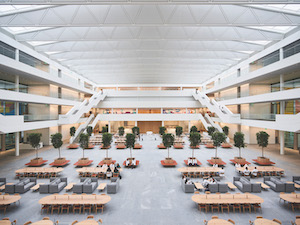 PHOTO: Roger Mastroianni
PHOTO: Roger MastroianniThe 80-foot-high, 27,000-square-foot Delos M. Cosgrove Courtyard provides a striking space for interprofessional interactions, study and relaxation. It draws maximum light from a specially engineered roof.
The Samson Pavilion is the centerpiece of the new $515 million Health Education Campus, a joint project of the university and Cleveland Clinic. The other building on the campus, a 132,000-square-foot dental clinic, is expected to care for more than 20,000 people annually on-site.
Designed by London architects Foster + Partners, the Samson Pavilion will be the educational home for students from the university's nursing, dental and medical schools—including the Cleveland Clinic Lerner College of Medicine. Students from the Jack, Joseph and Morton Mandel School of Applied Social Sciences will join the health students for team-based learning but will continue to take other coursework in their recently renovated and expanded building on the university's main campus.
Research has shown that when health professionals from various disciplines communicate well and work together, a result is improved patient satisfaction and care.
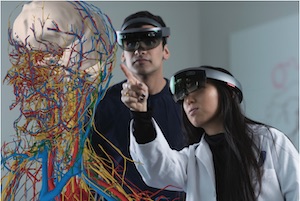 PHOTO: CWRU's Interactive Commons
PHOTO: CWRU's Interactive CommonsWith Microsoft HoloLens headsets, users can view a detailed 3D hologram of the human body, look inside organs from any angle and see how diff erent diseases and injuries affect parts of the body.
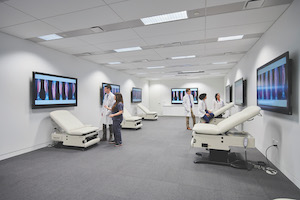 PHOTO: Roger Mastroianni
PHOTO: Roger MastroianniThe Samson Pavilion's second floor has several types of learning spaces and labs, including this living anatomy lab, which has LED screens at each examination table to enhance training.
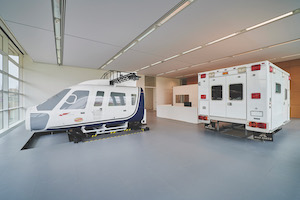 PHOTO: Roger Mastroianni
PHOTO: Roger MastroianniThe Callahan Family Critical Care Transport Simulator features the nursing school's updated helicopter simulator and an ambulance simulator, enabling students to experience what it's like to care for patients amid turbulent conditions and to properly transfer them from one team to another for transport.
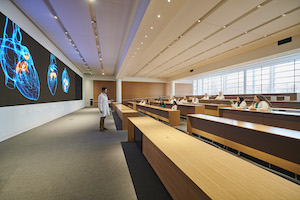 PHOTO: Roger Mastroianni
PHOTO: Roger MastroianniThe Samson Pavilion has 26 classrooms, including a 236-seat lecture hall featuring an 11-by-40-foot LED video wall that can display multiple images.
The Samson Pavilion includes classrooms, lecture halls, faculty offices, a medical library and a medical simulation center with 20 exam rooms and four acute-care spaces—as well as advanced technology to enhance and accelerate health education in the various fields.





